WE RIDE PRO CIRCUIT’S 2012 SUZUKI RM-Z450 MOTOCROSS BIKE

We wouldn’t be telling tales out of school to say that Suzuki has pressed the pause button as of late when it comes to motocross development. Maybe it’s just us, but we can’t help but feel that Suzuki is coasting because of poor sales for the RM-Z450. Who can blame them? Their whole fuel-injected RM-Z450 program has been an unmitigated disaster from day one.
It all started back in 2008 when Suzuki decided to get the jump on everyone by being the first manufacturer to come out with a fuel-injected 450cc motocross bike. They rolled the dice in an attempt to be on the cutting edge, but, instead, the 2008 RM-Z450 was delayed for months, missed the complete selling season, and Suzuki sold fewer 2008 fuel-injected RM-Z450s than they did carbureted 2007 models. It didn’t help that the engine cases broke, forcing every bike that had been shipped to the USA to be recalled for a series of fixes.
The next year was not kind to them, either. The 2009 Suzuki RM-Z450 was really just the 2008 model with the right-side engine case reinforced with additional ribs and thicker wall diameters. The buying public is not forgiving of high-profile failures, and by the time Suzuki had cured their EFI issues, gear whine and case breakages, sales had fallen significantly.
Suzuki’s confidence was at a new low heading into 2010. You could almost say that it was nonexistent, because the number of 2010 and 2011 RM-Z450s brought into the USA is often referred to in the hundreds instead of the thousands. The real bills of lading are tucked away in Suzuki’s vault, but it wouldn’t be a stretch to say that RM-Z450s were in short supply.
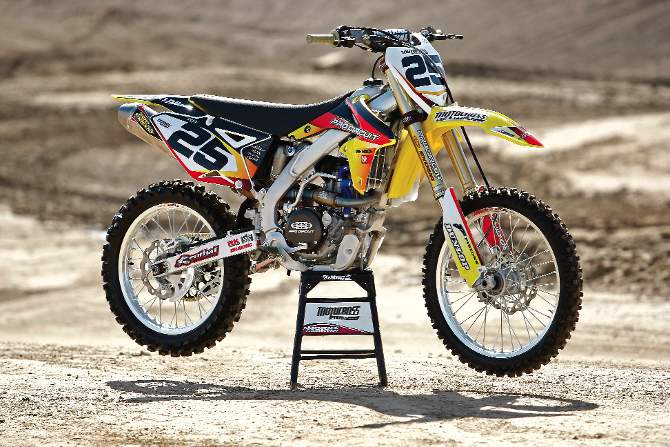
The Suzuki RM-Z450 has a lean lithe look that belies its 243-pound dry weight. Pro Circuit added touches to make the RM-Z450 look even better.
IN MXA’S OPINION, SUZUKI HAS NOT DONE A VERY GOOD JOB OF DELIVERING THEIR MESSAGE. COULD IT BE THAT THEY FIRED ALL OF THEIR PUBLIC RELATIONS PEOPLE?
Had Suzuki stayed in the doldrums, it is unlikely that they could have recovered their once glorious reputation in motocross. Thankfully, some executive at Suzuki decided to be proactive instead of passive. The 2010 and 2011 models got new cams, redesigned mufflers, bumped-up compression, a three-map ECU, new brake rotors, reverse 12-hole fuel-injector nozzles, reinforced frames and stronger crankshaft bearings. All of these changes improved the Suzuki RM-Z450’s performance. The improvements, however, didn’t make much of a dent in the sales advantages held by Yamaha, Honda, Kawasaki and KTM. Suzuki was learning that consumer confidence isn’t regained just by making changes, but by convincing the public that the changes actually make a difference.
In MXA‘s opinion, Suzuki has not done a very good job of delivering their message. Could it be that they fired all of their public relations people? Could it be that they didn’t deliver on the promotional front? Could it be that they lost heart and gave up?
There were bright spots for Suzuki and the RM-Z450. Ryan Dungey raced the 2010 RM-Z450 to both the AMA Supercross and AMA 450 National Championships (under the tutelage of Roger DeCoster). Then, in typical Suzuki fashion, they ruined that promotional bonanza by losing Dungey’s mentor, Roger DeCoster, to KTM. Suzuki regrouped in 2011 and looked good for a while, but several very high-profile mechanical failures cost them both the Supercross crown and the AMA 450 National title?and then they lost Dungey, who followed DeCoster to KTM.
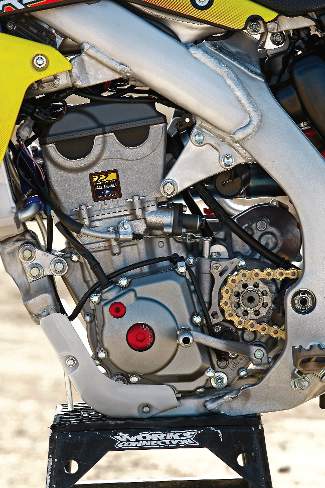
Pro Circuit’s engine mods added a healthy dose of power without losing any of the stocker’s usability.
Suzuki couldn’t get a break, and to make matters worse, they fired their complete race team heading into the 2012 season. The program was saved by Yoshimura, but it was reduced to a one-rider team?and that rider wasn’t Ryan Dungey. And the James Stewart experiment looked good for two weeks.
And now for the good news! Don’t let the Sturm und Drang get you down. There is good news at Suzuki, but it has been obscured by all the failures, breakages, drama and defections. The good news is that the 2012 Suzuki RM-Z450 is a very good race bike. In 2011, the RM-Z450 finished second in MXA‘s 450 shootout, and in 2012, it still managed to hang onto third?even though the only upgrade it got was a red stripe on the seat cover. Why were the MXA test riders so forgiving of Suzuki’s lack of attention to the 2012 RM-Z450? Because it is a really, really good race bike, and we thought that we could make it better.
THAT IS WHERE PRO CIRCUIT COMES INTO THE PICTURE. WE GAVE THEM CARTE BLANCHE TO DO THEIR THING TO A 2012 RM-Z450. THE BUDGET WAS NOT AN ISSUE.
That is where Pro Circuit comes into the picture. We gave them carte blanche to do their thing to a 2012 RM-Z450. The budget was not an issue, and while we don’t expect you to go for the high-priced spread on your ‘Zook, you can pick and choose from the things we did to make your RM-Z450 better. Here is what we did.
Engine: Ryan Dungey’s championship-winning RM-Z450 benefitted from Pro Circuit input, and it was no problem to have the same parts?or parts of equal dimensions?installed in our engine. We ran Pro Circuit high-lift cams ($744.95) with more duration to broaden the power. The Pro Circuit cams required stiffer valve springs ($299.95), and while we were at it, we replaced the stock valves with Del West flat-faced titanium valves ($715.90). The cylinder head was ported by Mitch Payton himself ($549.95). Mitch cleaned up the casting flaws and improved the flow on the intake side. While we had the engine apart, we replaced the stock piston with a high-compression Pro Circuit piston ($289.95), stiffer clutch springs ($79.95) and a high-pressure 1.6 radiator cap ($32.95).

Although blessed with a good engine, it is the RM-Z450’s handling that wins converts to the yellow bike.
Suspension: As a rule of thumb, we never run the stock fork springs on any RM-Z450. So, we started with that premise. Step one was to have Pro Circuit up the spring rate from 0.48 kg/mm to 0.50 kg/mm. Step two was to revalve the forks to make the damping more progressive. Step three was to return to the 0.48 springs and depend on the valving alone. We also added Pro Circuit’s National spring tubes. The National tubes replace the stock spring seat with units that flow more oil. The valving ($179.95), National spring tubes ($289.95), fork springs ($129.95) and internals parts ($169.95) brought the cost of the forks up to $770.
On the shock, we kept the stock spring, but revalved the damping to slow down the initial rebound and speed it up later in the stroke. Pro Circuit changed the high-speed collar to help make the compression adjuster more effective. Additionally, Pro Circuit makes a bladder cap that moves the nitrogen chamber away from the exhaust pipe to keep the super-hot exhaust pipe from heating up the nitrogen and stiffening up the compression.
THE TRUE PROOF OF ANY HOP-UP PROJECT ISN’T IN THE LOOKS, GLEAM OR GLITTER, BUT IN THE PERFORMANCE.
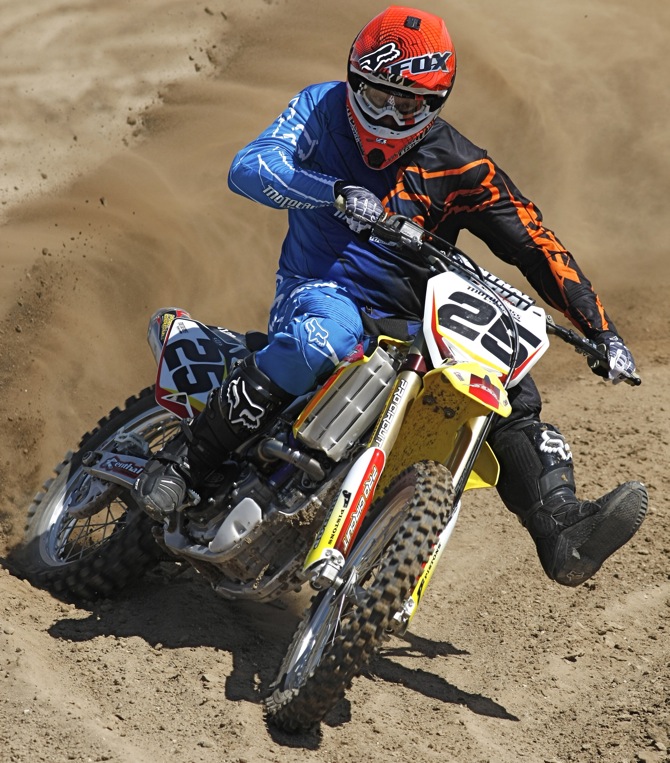
The last change we made to the suspension was to add a 1.5mm-longer shock linkage (132.5mm to 134mm). This lowered the rear of the bike by 10mm, which allowed us to slide the forks up in the clamps to help the overall handling. Additionally, the longer link increased the damping’s starting point to lessen wallowing.
The shock revalve was $149.95. The spring collar and shim kit were $179.95. The bladder cap was $124.95, and the shock linkage was $224.95 for a total of $680.
Accessories: Half of the MXA test crew doesn’t care much about add-on accessories; the other half can’t live without a little foof and bling. Pro Circuit’s add-on parts contributed $1370 to the bill for MXA‘s project bike, and just like the MXA test riders, you need to look at each piece with a discerning eye toward the budget. Let’s start with the expensive pieces and work our way down.
Pro Circuit triple clamps ($500 top and bottom): They look sweet and are more rigid than the stockers, but the offset is the same.
Radiator hose kit ($199.95): Pro Circuit’s silicone hoses are more durable.
Pro Circuit team graphics ($199.95): The design and look of Pro Circuit’s 2012 graphics kit is a vast improvement over their previous design. This kit includes a seat cover.
Pro Circuit clutch cover ($169.95): We love the works bike looks.
Renthal: The Renthal 996 bars, Kevlar grips and 50-tooth rear sprocket are all standard-issue mods that most riders will make in due time.
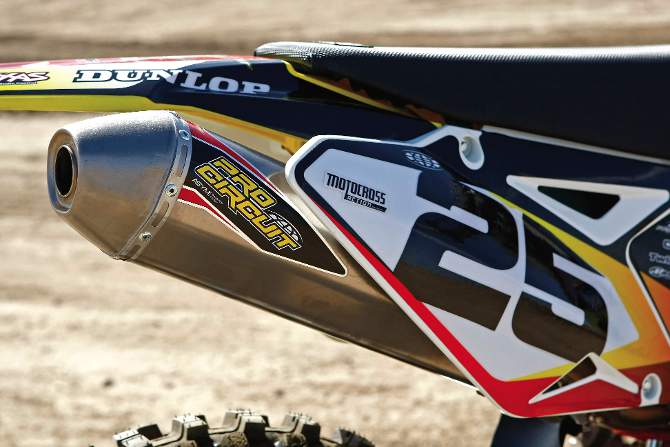
Step one in any RM-Z450 mod project starts with the exhaust system. Pro Circuit has both stainless and titanium systems.
Miscellaneous: The anodized axle blocks ($59.95), engine plug kit ($69.95), rear-brake clevis ($54.95), 1-1/8-inch bar mounts ($99.95) and forged Sunline levers ($19.95 clutch, $24.95 brake) all add to the total package.
The true proof of any hop-up project isn’t in the looks, gleam or glitter, but in the performance. It should be noted that we like the stock RM-Z450. We don’t love every aspect, but we like most of it. On the track, it was obvious that Pro Circuit’s engine mods returned on investment. The bike was considerably faster (about five horses faster with VP fuel) without changing the RM-Z450’s sweet personality. We liked the mellow nature of the stock powerband, and Pro Circuit’s full-race setup didn’t turn the RM-Z450 into a beast. It pulled hard off the bottom and was potent in the midrange. All in all, it is a faster version that lets you ride faster.
As for the handling, we liked everything about it. Lowering the chassis by almost a half-inch, which brings the weight down more effectively than most centralization of mass innovations, helped the already excellent-turning Suzuki frame hug the ground better. It felt more stable in the rough and actually turned better. And if you know how quickly and accurately a Suzuki turns, you know that is impressive.
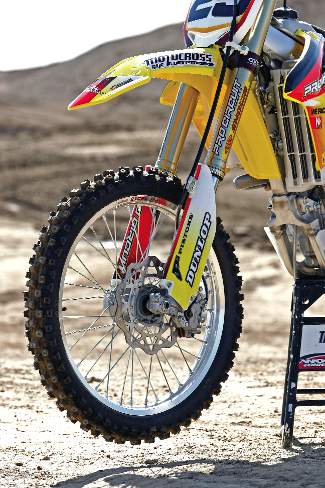
Thanks to their Kawasaki race team, Pro Circuit knows all there is to know about Showa forks and shocks.
Suzuki specs excellent suspension components on the 2012 RM-Z450. The Showa shock has a 50mm body and 18mm shock shaft, while the 47mm Twin Chamber forks are made whole by the addition of more progressive damping (and a few AMA National tricks).
WHEN EVALUATING THE SUCCESS OF MXA’S PROJECT BIKES, WE HAVE TO FACTOR IN THE AREAS THAT REALLY NEEDED ATTENTION.
When evaluating the success of MXA‘s project bikes, we have to factor in the areas that really needed attention. Obviously, the power gains, suspension mods and chassis changes were all needed, but what about the other nagging RM-Z450 issues?
(1) Overheating. The stock 1.1 kpf radiator cap isn’t sufficient to prevent boiling. We installed a high-pressure 1.6 kpf radiator cap to raise the boiling point. This is a must on a Suzuki
(2) Clutch. Suzuki needs to work on their clutch. It makes weird whirring noises (like the idler gear is dragging on something) and is always on the verge of slipping. We resorted to stiffer clutch springs to keep the pack together, but this is just a band-aid. In the end, we gave up and put in a complete Hinson clutch.

We fiddled with the stock clutch, but eventually gave up and went the Hinson route. That fixed it.
(3) Rear-brake adjustment. Suzuki’s rear-pedal adjustment has a very narrow window. If you miss it, the rear brake will burn up. Pro Circuit added an anodized rear-brake clevis, but we think it aggravated the RM-Z450’s adjustment problems. We milled it down.
(4) Shifting. There is nothing MXA or Pro Circuit can do about the RM-Z450’s balky upshifts and phantom shifting.
In the end, we loved the Pro Circuit engine, suspension and chassis mods. The Suzuki RM-Z450 offers the kind of handling prowess that you can’t get anywhere else. Imagine how much better it is with the addition of horsepower and raceable suspension.




Comments are closed.